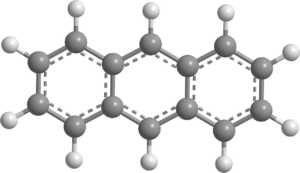Table of Contents
Aromatic hydrocarbons are defined as “unsaturated hydrocarbons with one or more planar six-carbon rings called benzene rings to which hydrogen atoms are connected.” A benzene ring may be found in several aromatic hydrocarbons (also referred to as an aromatic ring). The benzene ring is stabilized by resonance, and the pi electrons in the ring structure are delocalized.
The aromatic hydrocarbons that lack a benzene ring are referred to as heteroarenes. Huckel’s rule (total number of pi electrons in a monocyclic ring = 4n + 2, where n is any positive integer or zero) is followed by all of these heteroarenes.
Before the physical process controlling aromaticity was identified, the name “aromatic” simply referred to the fact that many such compounds had a sweet or pleasant odor; however, not all aromatic compounds have a sweet odor, and not all compounds with a sweet odor are aromatic compounds.
A minimum of one carbon is replaced by nitrogen, oxygen, or sulfur in these molecules. Furan (which includes oxygen) and pyridine are two common examples of heteroarenes (contains nitrogen).
Properties of Aromatic Hydrocarbons
“Benzene was the first chemical classified as an aromatic hydrocarbon.” It is also the most difficult aryl hydrocarbon to synthesize. Each benzene ring carbon atom possesses two carbon-carbon sigma bonds, one carbon-hydrogen sigma bond, and one double bond with a neighboring carbon in which the pi-electron is delocalized.
A circle inside the hexagon represents the delocalization of pi electrons in the benzene molecule. The bond order of all carbon-carbon bonds in this molecule is 1.5, and this equivalence may be explained using benzene resonance structures.
The following are some general characteristics of aromatic hydrocarbons:
- These chemicals are aromatic (additional stability granted by resonance)
- In these compounds, the carbon-to-hydrogen atom ratio is relatively high.
- When aromatic hydrocarbons are burned, they produce a yellow, sooty blaze.
- Electrophilic substitutions and nucleophilic aromatic substitution reactions are common in these molecules.
Reactions of Aromatic Hydrocarbons
Aromatic hydrocarbons are used as the main reactant in many organic chemical processes.
Aromatic Substitution Reactions
These reactions involve the substitution of a different substituent group for one of the substituents on the ring of an aromatic hydrocarbon, most typically a hydrogen atom.
The following are examples of frequent aromatic substitution reactions:
- Aromatic nucleophilic substitution reactions
- Aromatic electrophilic substitution reactions
- Aromatic radical nucleophilic substitution reactions
The electrophilic substitution found in the nitration reaction of salicylic acid is an example of an aromatic substitution reaction.
Coupling Reactions
The coupling of two radical fragments is accomplished with the aid of a metal catalyst in these sorts of reactions. The following types of bonds can form when aromatic hydrocarbons undergo coupling processes.
Carbon-carbon bonds can be generated as a result of arene coupling processes, and compounds such as vinyl arenes, alkyl arenes, and so on are created. In these reactions, carbon-oxygen bonds can form, resulting in the creation of aryloxy molecules. In coupling processes, carbon-nitrogen bonds can form, yielding compounds such as aniline.
Hydrogenation Reactions
Arene hydrogenation processes often result in the creation of saturated rings. The reduction of 1-naphthol into a mixture including distinct isomers of decalin-ol is an example of such a reaction. Another example of such a reaction is the hydrogenation of resorcinol using spongy nickel (also known as Raney nickel) and aqueous NaOH. This reaction begins with the production of an enolate, which is then alkylated (with methyl iodide) to generate 2-methyl-1,3-cyclohexanedione.
Uses of Aromatic Hydrocarbons
Aromatic hydrocarbons are commonly used in biological and synthetic processes. The following are some of the many applications for aromatic hydrocarbons:
- Naphthalene is a key ingredient in the manufacture of mothballs.
- Phenanthrene, an aryl hydrocarbon, is employed in the manufacture of medicines, dyes, and explosives.
- TNT, or trinitrotoluene, is a very significant aromatic hydrocarbon that is commonly utilized in explosives.
- Aromatic hydrocarbons are widely used in the plastic and petrochemical industries.
- The green pigment present in plants, more often known as chlorophyll, is made up of aromatic hydrocarbons and is crucial in the process of plant food production.
- These aromatic hydrocarbons are also found in nucleic acids and amino acids in the human body.
- In model glue, methylbenzene, an aromatic hydrocarbon, is utilized as a solvent.
Polycyclic Aromatic Hydrocarbons (PAHs)
A polynuclear aromatic hydrocarbon is one composed of fused aromatic ring molecules. These rings have delocalized electrons on one or more sides. PAHs can also be thought of as molecules formed by the fusion of two or more benzene rings. Only carbon and hydrogen atoms are found in polynuclear aromatic hydrocarbon molecules. These can be present in coal, tar, oil, and some prepared meals like smoked fish and burnt toast.
Naphthalene is a frequent example of these polycyclic hydrocarbons. Pollutants are defined as these chemicals.
They are also known as PAH (polycyclic aromatic hydrocarbon), PAH (polyaromatic hydrocarbon), and PAH (polyaromatic hydrocarbon).
Examples: Polynuclear aromatic hydrocarbons come in a variety of forms. Several distinct PAHs are commonly discovered together. Anthracene, Phenanthrene, tetracene, pyrene, pentacene, etc. are some examples.

Also read: Important Topic of Chemistry: Allotropic Forms
FAQs
What happens when aromatic compounds react?
Aromatic compounds, commonly known as arenes, undergo substitution reactions in which an electrophile replaces the aromatic hydrogen, resulting in electrophilic substitution. Metal cross-coupling, such as the Suzuki reaction, enables the formation of carbon-carbon bonds between two or more aromatic molecules.
What is Sandmeyer's reaction, give an example?
The Sandmeyer reaction is a chemical process that produces aryl halides from aryl diazonium salts by using copper salts as reagents or catalysts. An example is a radical-nucleophilic aromatic substitution.
What are aromatic hydrocarbons made of?
Monocyclic aromatic hydrocarbons are made up of a single aromatic ring (MAHs). Benzene, toluene, ethylbenzene, and xylenes (BTEX) are the most volatile and water-soluble aromatic hydrocarbons, and they are well-known environmental pollutants.





